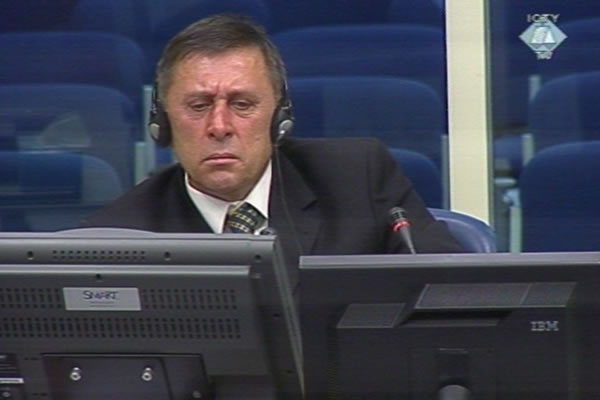Home
WITNESSES DEFEND KARADZIC AND THEMSELVES
Two former members of the Sarajevo-Romanija Corps confirmed Radovan Karadzic’s claims that the Bosnian Serbs were innocent of the crimes against the citizens of Sarajevo. The two witnesses then had to clarify their involvement in the war crimes. Zeljko Bambarez had to explain the use of prisoners as forced labor in dangerous conditions. One of the Tribunal’s previous judgments identified Milorad Sehovac as the person who ordered a man to be killed
 Zeljko Bambarez, defence witness of Radovan Karadzic
Zeljko Bambarez, defence witness of Radovan Karadzic After the commander of the 1st Ilidza Brigade Vladimir Radojcic completed his evidence, former Bosnian Serb president Radovan Karadzic called two more former members of the Sarajevo-Romanija Corps, the formation that held positions around Sarajevo and, as alleged in the indictment, terrorized the population with artillery and snipers. The first to appear in the witness stand was Zeljko Bambarez, a platoon commander in the Sarajevo-Romanija Corps. After Bambarez completed his evidence, Karadzic called the commander of the 2nd Sarajevo Brigade, Milorad Sehovac.
The testimony of both witnesses fit well into the pattern of evidence Karadzic has been adducing to challenge the charges of artillery and sniper terror campaign against the population of Sarajevo. Both witnesses claimed that their units operated only in defense and that they never ‘issued orders or intended to cause civilian casualties or terrorize civilians’. They respected ceasefires and when they fought they did it by strictly adhering to international conventions. If they had artillery and snipers, they claim they used them only in combat, avoiding civilian victims at all costs.
The accused read out the summaries of the witnesses’ written statements containing those claims. After that, in brief examinations-in-chief both witnesses confirmed other parts of Karadzic’s defense case. Bambarez commented on the photos the accused showed him and tried to convince the Trial Chamber that the sites where civilians were shot by snipers could be seen from the BH Army sniper positions – primarily the ‘red building’ in Grbavica near the Vrbanja Bridge, half of which was held by the Serb forces and half by the Muslims. Karadzic wants to instill reasonable doubt in the Trial Chamber about the prosecution’s allegation that the Bosnian Serb army soldiers were responsible for sniper incidents listed in the indictment.
Bambarez confirmed that fire could be opened from the Bosnian army positions in the ‘red building’ on the civilians in the city, although the photos seemed to show that the view was obstructed by a number of skyscrapers. The witness explained that the photos were taken after the war. During the war, the buildings were torn down and were ‘a tiny bit’ lower so they didn’t obstruct the view to that extent. In the cross-examination, the witness said that the BH Army didn’t have sniper positions at all in the ‘Muslim part of the building’. It thus remained unclear why Karadzic tried to prove that there was a good line of sight to the sniper attack sites.
On the other hand, Colonel Sehovac underscored in the examination-in-chief the commitment of the Bosnian Serb forces to defending their positions and not attacking the city and civilians in particular. As the witness said, his brigade ‘treated the ceasefires properly’; they opened fire only if they were attacked.
Apart from the similarities in their testimonies, the two witnesses share another common trait. Both witnesses were cautioned before giving evidence that they didn’t have to respond to any questions that might incriminate them and that could be used against them if they were charged with war crimes. Bambarez was given the caution because of the proof of his involvement in using prisoners for ‘engineering works’ and digging trenches on the front lines. This was mentioned in a document from December 1993 signed by the witness. Bambarez didn’t deny that a ‘mixed platoon of prisoners’ – mixed because there was a Serb in it – was indeed used to work at the separation line. The witness believes there is nothing controversial about it. As the prisoners dug a trench, he stood next to them. They worked ‘in the same conditions’ as he did, the witness argued.
On the other hand, Milorad Sehovac was mentioned in Momcilo Krajisnik’s judgment as the person who ordered a crime in Brcko. The prosecutor noted that the judgment established that on 10 May 1992, the witness issued an order to take out a Croat detainee from the fire station in Brcko and to kill him. Serb soldiers took out the prisoner, a shot rang out, and the man was never seen again. As he listened to the findings in the judgment, Sehovac laughed and then said the ‘allegations are false’. At the time, Sehovac said he worked on administrative tasks in the military department and didn’t have operational authority.
Before joining the Bosnian Serb army, Sehovac served as an officer in the JNA. When the war ended, Sehovac returned to what was in effect his home office - the Yugoslav Army. In 2002, he retired. Now he is living a quiet life in Novi Sad despite the allegations in the judgment of Momcilo Krajisnik. No criminal charges were pressed against him. Sehovac’s cross-examination continues tomorrow.
Photos
Linked Reports
- Case : Karadzic
- 2012-12-11 WHAT ARE THE ‘MOST PROFITABLE’ TARGETS?
- 2012-12-07 ‘TYPICAL TERRORISM’ IN SARAJEVO
- 2012-12-06 DID BATKO HAVE POLITICAL BACKING?
- 2012-12-13 WITNESS ORDERED HIS SOLDIERS TO USE BOMBS HE KNEW NOTHING ABOUT
- 2012-12-14 EXPLOSIVES EXPERT CONTESTS FINDINGS OF BALLISTICS EXPERT
- 2012-12-17 SHELLING ‘IN EXTREME NECESSITY’, ARMING ‘SPONTANEOUSLY’

